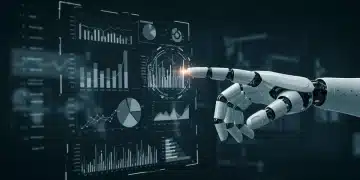Understanding NFTs: Beyond Digital Art

Understanding NFTs is essential as they represent unique digital assets verified on the blockchain, impacting various industries like art, gaming, and real estate while also facing challenges such as market volatility and environmental concerns.
Understanding NFTs is crucial in today’s digital landscape, extending far beyond just art. Have you ever wondered how these tokens reshape ownership in virtual spaces? Let’s dive in!
What are NFTs and how do they work?
NFTs, or Non-Fungible Tokens, are unique digital assets that represent ownership of a specific item or piece of content on the blockchain. Unlike cryptocurrencies like Bitcoin or Ethereum, which are fungible and can be exchanged for one another, NFTs are distinct and cannot be replaced.
These tokens have taken the digital world by storm, especially in fields like art and music. An NFT can symbolize anything from digital art to virtual real estate. As they grow in popularity, understanding how NFTs function is essential.
How NFTs Work
At their core, NFTs utilize blockchain technology, which serves as a secure ledger. This technology records the ownership and transaction history of each token, making it easy to verify authenticity.
- Each NFT has a unique identifier, ensuring no two tokens are alike.
- They can be bought, sold, or traded on various online marketplaces.
- Smart contracts automate transactions, creating a secure and seamless exchange process.
- Artists and creators often receive royalties every time their NFT is sold to a new owner.
The appeal of NFTs lies in their ability to provide proof of ownership and scarcity. Owning an NFT can mean holding a rare digital asset, much like owning a collectible item in the physical world.
Moreover, NFTs are gaining traction outside the art world. They are being used in gaming, virtual reality, and even in ticketing for events. This versatility showcases their transformative potential in numerous industries.
The impact of NFTs on digital art
The rise of NFTs has profoundly changed the landscape of digital art. Artists now have new opportunities to sell their work directly to collectors without needing intermediaries. This shift has empowered creators and given them more control over how their art is valued and sold.
Before NFTs, digital artists often faced challenges in proving ownership and authenticity. With NFTs, each piece of artwork can have a verified ownership record on the blockchain. This not only protects artists’ rights but also enhances the value of their work.
Benefits for Artists
NFTs offer several advantages to digital artists:
- Direct sales to collectors, increasing their revenue.
- Royalties on secondary sales, allowing them to earn ongoing income.
- Access to a global audience and new markets.
- The ability to showcase their work in unique digital galleries.
This democratization of the art market means that more artists can succeed and reach audiences who appreciate their work. Moreover, it allows for a wider diversity of artistic expression in the digital space.
However, the impact of NFTs extends beyond just artists. Collectors now have a new way to engage with art. The excitement of owning a unique piece, combined with the potential for future value appreciation, attracts many to invest in NFTs. The digital ownership experience is more immersive, with collectors able to display their NFTs in virtual galleries or participate in communities centered around their favorite artists.
As the NFT market continues to grow, it’s clear that this technology has made lasting changes to the world of art. But it also raises questions about the sustainability of such a market and its long-term effects on the art community.
NFTs in gaming and virtual worlds

NFTs are revolutionizing the world of gaming and virtual worlds, creating new opportunities for players and developers alike. In this digital age, players are beginning to own their in-game assets truly, thanks to NFTs.
In traditional gaming, players spend countless hours earning items, skins, and characters that they can never fully own. With NFTs, these assets become unique tokens on the blockchain. This means players can buy, sell, or trade items freely, adding real-world value to their achievements.
Benefits of NFTs in Gaming
The introduction of NFTs in gaming comes with several benefits:
- Real ownership of in-game assets, ensuring players can retain their hard-earned items.
- Interoperability, allowing assets to be used across different games.
- New revenue streams for developers through the sale of NFTs.
- Enhanced player engagement as they invest in their gaming experiences.
As players now own their assets, they can express their creativity, whether by customizing their virtual characters or trading unique collectibles. This sense of ownership cultivates a stronger connection between players and the game.
Virtual worlds are also embracing NFTs. Platforms such as Decentraland and Axie Infinity allow users to create and trade virtual real estate and digital pets. Users can build their communities and economies around these unique assets, further enhancing the immersive experience.
In these virtual environments, players can attend events, socialize with others, and explore blockchain-based art installations. This integration of NFTs transforms how people perceive and interact with digital worlds, making them more engaging and expansive.
Exploring NFT use cases beyond art
While NFTs are widely known for their role in the art world, their use cases extend far beyond that. NFTs are impacting various industries, contributing to innovative methods of ownership, identification, and commerce.
In the gaming sector, NFTs enable players to own in-game items that can be traded or sold. This concept gives players real control over their assets, as they can move items between games or profit from them. As a result, players feel more invested in their gaming experiences.
Real Estate and Virtual Property
NFTs are transforming how real estate is bought and sold. By representing ownership of properties as NFTs, transactions can become more transparent and efficient.
- Proof of ownership is recorded on the blockchain.
- Buyers can purchase virtual lands in platforms like Decentraland.
- This allows for virtual tours and seamless sales.
- Property ownership can include digital assets as well.
This innovative approach creates a marketplace for both digital and physical real estate, merging traditional and virtual economies.
Another exciting use case for NFTs lies in music and entertainment. Artists can release exclusive albums or tracks as NFTs, allowing them to engage directly with their fans. This method can include limited edition releases that offer unique experiences, such as backstage access to concerts or special merchandise.
Collectibles and Identity Verification
NFTs can represent not just art or music but also collectibles, like digital trading cards. These items can be bought and sold just like physical collectibles without the need for a middleman.
- Collectors can own unique digital cards or memorabilia.
- Items can appreciate in value over time.
- This opens up new possibilities for fans and collectors alike.
- They can be shared and showcased in online galleries.
Moreover, NFTs have great potential in identity verification. Educational credentials, certificates, and personal identification could be managed through NFTs, providing a secure and easily verifiable way to prove qualifications and achievements.
As various industries continue to explore the potential of NFTs, it becomes evident that these digital assets hold the promise of true ownership and new economic models.
Challenges and future of NFTs
The world of NFTs is exciting, but it also faces several challenges that could impact its future. As this technology evolves, it is important to recognize the hurdles that need to be addressed.
One major challenge is the environmental impact associated with NFTs. Most NFTs are built on blockchain platforms that require significant energy consumption. This has raised concerns about the carbon footprint that these digital assets leave behind.
Market Volatility
Another issue is market volatility. The prices of NFTs can fluctuate wildly, driven by trends, hype, and speculation. This instability makes it difficult for artists and collectors to gauge the true value of their assets.
- Buyers may hesitate to invest due to unpredictable price swings.
- New artists can struggle to gain recognition amidst fluctuating market attention.
- High-profile sales may distort perceptions of overall market health.
The authenticity of NFTs is also a concern. There have been cases of artists’ works being tokenized without their permission, leading to copyright infringements. Protecting the rights of creators is essential if the NFT space is to thrive.
Looking to the future, NFTs have the potential to integrate more with the traditional economy. We may see more brands exploring NFTs as a way to connect with consumers, driving innovation in marketing and fan engagement.
Regulatory Landscape
The regulatory landscape for NFTs is still evolving. As governments and organizations form clearer regulations around digital assets, compliance will be crucial for future growth.
- Legal frameworks will help protect buyers and sellers.
- Standards may emerge to ensure authenticity and provenance.
- Consumer protection laws could shape how NFTs are marketed.
In summary, while the challenges are significant, the future of NFTs may hold exciting possibilities. Creators, collectors, and innovators will continue to shape this space, finding solutions to the current issues while exploring new avenues for digital ownership.
FAQ – Frequently Asked Questions about NFTs
What are NFTs and how do they work?
NFTs, or Non-Fungible Tokens, are unique digital assets verified on the blockchain that represent ownership of specific items, ensuring authenticity.
What challenges do NFTs face in the market?
NFTs face challenges like environmental impact, market volatility, copyright issues, and the need for regulatory clarity.
How are NFTs used beyond digital art?
NFTs are used in various fields, including gaming, music, real estate, and identity verification, allowing for true ownership and innovative applications.
What does the future hold for NFTs?
The future of NFTs looks promising, with potential growth in brand engagement, compliance with regulations, and new market possibilities.





